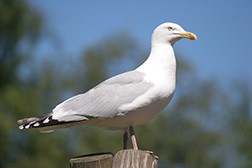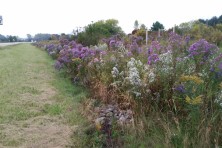OutDOORs with Coggin Heeringa: Herring Gulls In Heat
- Share
- Tweet
- Pin
- Share

Herring Gull. Public domain photo.
On a swelteringly summer day, a visit to the beach is a great idea – for us and the birds. If we humans are roasting in high temperatures, imagine what it must be like for creatures covered in the equivalent of a down comforter. But no matter how hot, the quintessential birds of the beach, the gulls, seem able to get some relief.
And gulls need relief. Sandy beaches are extremely hot. Birds that nest or even loaf by the shore are in real danger of overheating. Have you ever noticed when gulls gather on a beach, they all seem to be facing in the same direction? Fact is, gulls almost always face the sun.
According to The Birder’s Handbook, by Dobkin, Ehrich and Wheye, “Nesting Herring Gulls will rotate 180 degrees to constantly face the sun on hot, windless days. This effectively minimizes the amount of radiative heat gain, allowing the gulls to present only their more reflective plumage (white head, neck and breast) to direct sunlight.”
In the wintertime, we’ve all observed gulls squatting or standing on one foot (with the other foot tucked into the nice warm feathers) to prevent the loss of body heat from un-feathered legs. The reverse is true in summer. Birds fully expose both legs or, better, wade or paddle in the water to help dissipate heat.
When sitting on their nests, parent gulls pant like dogs in an effort to keep cool. The wider they open their beaks, the greater the evaporation from their mouth linings, throats and lungs and that helps draw the heat from their bodies.
For the first few days after hatching, gull chicks have an especially difficult time with thermal regulation. Though the beach generally has no natural shade, the adult gulls cast shadows. Somehow young gulls know to use their parents as beach umbrellas and to huddle in the shade.
We might learn from the gulls. Shade helps beat the heat. Our homes and work places are much cooler if shades or curtains are closed on sunny days, especially on the south and west sides of a building.
Better yet, planting shade trees protects buildings from the full brunt of the afternoon sun. With or without air conditioning, shade is a great way to increase comfort and save energy, and it’s almost as good as a visit to the beach to beat the heat.


